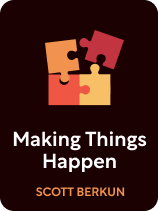

This article is an excerpt from the Shortform book guide to "Making Things Happen" by Scott Berkun. Shortform has the world's best summaries and analyses of books you should be reading.
Like this article? Sign up for a free trial here.
Want an overview of Making Things Happen by Scott Berkun? What does a project manager do?
In Making Things Happen by Scott Berkun, he explains what makes a good project leader and how you can better communicate with the people you work with if you find yourself in that role. In the book, Berkun answers the many questions you may have on leadership and project management.
Read on for an overview of Making Things Happen by Scott Berkun.
Scott Berkun’s Making Things Happen
In Making Things Happen by Scott Berkun, he shares his ideas on successful project management. He offers not a one-size-fits-all approach to project management, but rather different ideas that might work for you. As Berkun points out, every project will be different—different goals, different people, different problems. Because of this, a project manager should learn as many different management strategies as she can and apply them when necessary.
As a project manager for Microsoft, Berkun oversaw the development of several important software projects, such as Internet Explorer and Windows. He’s also the author of several other books on design, including How Design Makes the World. Although Berkun excels at managing software projects, the advice in this book is meant for any project, big or small, in which people work together to build something. Whether you’re an experienced manager or just someone who wants to work better with others, this book is for you.
How to Be a Strong Leader
For a project manager to be successful, she needs to understand the basics of what makes a strong leader, Berkun argues. A strong leader is someone who makes things happen by getting the most out of the people she works with. To get the most out of others, Berkun states that a project manager should foster communication and trust among the entire team. Let’s look at how to do each of those things.
Build and Maintain Trust
To be a strong leader of a project, it’s important that team members trust in your motivations and abilities, and that you can trust them to get the work done. When there’s mutual trust between a manager and the rest of the team, good things happen. According to Making Things Happen, there are several ways Scott Berkun says a manager earns trust: by staying true to her word, by clearly defining roles and expectations, and by delegating responsibilities and decisions to others. Let’s look at each.
As a project manager, when you consistently follow through on your word, it helps build trust in two key ways. First, it gives the team confidence that what you say is important. Second, staying true to your word makes it more likely that others will do the same. When team members know they can depend on you, they’ll want to show that you can depend on them.
The Planning Phase
Now that we know what makes a strong leader, let’s move on to the first phase of any project: planning. In Making Things Happen by Scott Berkun, he argues that the planning phase is about figuring out what the project is trying to accomplish. This phase consists of three sub-steps: setting a schedule, determining requirements, and creating vision documents.
However, there is no one-size-fits-all method for project planning—some projects may involve extensive planning while others may use a trial-and-error approach in which very little planning is needed. As a project manager, to determine what type of planning your team and project needs, you must first understand the factors that affect the planning process.
(Shortform note: Even though every project requires its own planning process, the author of Getting Things Done states that a lot of companies and organizations use formal planning methods that get them into trouble. One major problem organizations face using formal planning methods is that they spend too much time planning without a stated purpose. The author of Getting Things Done, however, recommends starting with a specific purpose—a why to the project—and building from there. This lets you create a custom plan for your project, which increases the chances of success.)
#1: Schedules
Berkun states that a project manager must be aware that schedules, especially early on in the project, are rough estimates based on limited information. Estimating is hard, as it’s impossible to know how the work will develop and what might change over the course of the project, so a schedule shouldn’t be seen as a realistic prediction. The manager, as well as the rest of the team, should recognize that the schedule is merely a jumping-off point that will hopefully get more accurate as time goes on.
#2: Requirements
Once you have a schedule, you can then move on to gathering requirements. According to Berkun, a requirement is any condition that needs to be met for the project to be considered finished. Project requirements help determine what the team is trying to accomplish or what problem the project is going to solve. . They should be simple, so designers have room for interpretation and can brainstorm different ways to solve the problem.
#3: Vision Document
According to Scott Berkun’s advice in Making Things Happen, there are a few key qualities a vision document should have. Most importantly, the main vision set forth in the document should be easy to understand. When a vision is clear on the project’s goals, people can easily refer to it at any time to help them answer questions or make decisions. A vision should also be motivational, so that the team understands how their work contributes to the overall goals of the project. Finally, a vision document should integrate many ideas into a coherent whole. A manager should include all helpful information in the vision document but do so in a way that remains focused and digestible.
The Design Phase
In Making Things Happen, Scott Berkun says using prototypes in the design phase can help answer questions or help a design team test a product’s technical viability. When a team has an idea worth exploring further but isn’t ready to fully commit to it, prototypes can be especially useful. There are several different ways to go about prototyping, and which one is best will depend on the project. In general, the more complex the prototype, the more questions it’ll be able to answer. Let’s explore a few different prototyping methods a project manager may use:
Several small prototypes: When you have many potential designs, making several smaller, less sophisticated prototypes in the beginning can help you decide which one might work best.
Combine the best ideas: Alternatively, if you have multiple designs, take the best ideas from each design, combine them into one prototype, and see what works and what doesn’t.
Determine what needs to be tested the most: Figure out what aspects of the design need to be tested the most and make one prototype that tests them all.
The Building Phase
Once you’ve completed the design for a project, it’s time to begin building the product. In Making Things Happen, Scott Berkun points out that a lot of the heavy lifting is done in the planning phase, and a project manager’s main responsibilities in the building phase are anticipating and finding solutions to problems.
How to Preempt Major Problems
According to Berkun, a project manager should always try to anticipate any issues or challenges that might derail the project. He argues that the best way to do this is to ask yourself questions that, when answered, provide insight into how the project is going. These questions should help make sure you are staying true to the project’s goals and that everyone is working toward those goals.
On a daily basis, you should ask yourself, “Are the tasks we’re working on today contributing to the goals of the project?” and: “Are the tasks being completed in a way that meets the requirements of the project?” If the answer to both of these questions is yes, you can be fairly confident the project is moving forward efficiently.

———End of Preview———
Like what you just read? Read the rest of the world's best book summary and analysis of Scott Berkun's "Making Things Happen" at Shortform.
Here's what you'll find in our full Making Things Happen summary:
- Answers to the questions you have about leadership and project management
- What managers can do at each phase of a project to ensure its success
- Why schedules are unreliable yet useful






